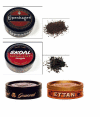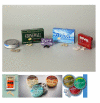Tobacco harm reduction: an alternative cessation strategy for inveterate smokers
- PMID: 17184539
- PMCID: PMC1779270
- DOI: 10.1186/1477-7517-3-37
Tobacco harm reduction: an alternative cessation strategy for inveterate smokers
Abstract
According to the Centers for Disease Control and Prevention, about 45 million Americans continue to smoke, even after one of the most intense public health campaigns in history, now over 40 years old. Each year some 438,000 smokers die from smoking-related diseases, including lung and other cancers, cardiovascular disorders and pulmonary diseases. Many smokers are unable--or at least unwilling--to achieve cessation through complete nicotine and tobacco abstinence; they continue smoking despite the very real and obvious adverse health consequences. Conventional smoking cessation policies and programs generally present smokers with two unpleasant alternatives: quit, or die. A third approach to smoking cessation, tobacco harm reduction, involves the use of alternative sources of nicotine, including modern smokeless tobacco products. A substantial body of research, much of it produced over the past decade, establishes the scientific and medical foundation for tobacco harm reduction using smokeless tobacco products. This report provides a description of traditional and modern smokeless tobacco products, and of the prevalence of their use in the United States and Sweden. It reviews the epidemiologic evidence for low health risks associated with smokeless use, both in absolute terms and in comparison to the much higher risks of smoking. The report also describes evidence that smokeless tobacco has served as an effective substitute for cigarettes among Swedish men, who consequently have among the lowest smoking-related mortality rates in the developed world. The report documents the fact that extensive misinformation about ST products is widely available from ostensibly reputable sources, including governmental health agencies and major health organizations. The American Council on Science and Health believes that strong support of tobacco harm reduction is fully consistent with its mission to promote sound science in regulation and in public policy, and to assist consumers in distinguishing real health threats from spurious health claims. As this report documents, there is a strong scientific and medical foundation for tobacco harm reduction, and it shows great potential as a public health strategy to help millions of smokers.
Figures
References
-
- Centers for Disease Control and Prevention 2005 Cigarette smoking among adults – United States, 2004. MMWR. 54:1121–1124. - PubMed
-
- Centers for Disease Control and Prevention, 2005 Annual smoking-attributable mortality and years of potential life lost, and productivity losses – United States. MMWR. 54:625–628. 1997–2001. - PubMed
-
- Kirkland LR. The nonsmoking uses of tobacco. New Engl J Med. 1980;303:165. - PubMed
LinkOut - more resources
Full Text Sources
Medical
Research Materials
Miscellaneous





